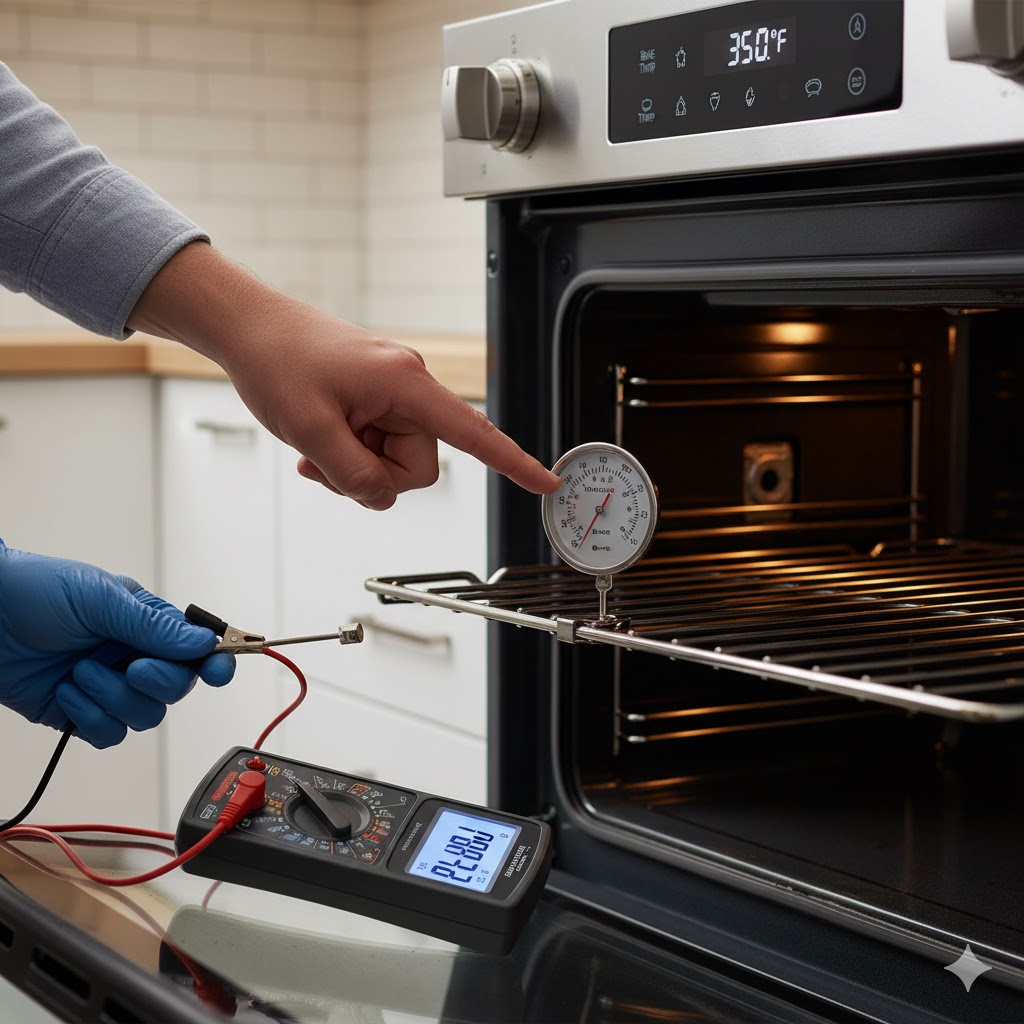Stop Ruining Meals: Diagnosing and Correcting Inaccurate Oven Temperatures
There is nothing more frustrating for a home cook than following a recipe perfectly, only to pull out a meal that is either scorched black or still raw in the middle. If your food is consistently burning, undercooking, or taking far longer than the recipe suggests, the problem isn’t your cooking skills—it’s likely your oven’s inaccurate temperature control.
A difference of just $25^circ F$ or $15^circ C$ can ruin baked goods, roasts, and casseroles. Fortunately, most temperature problems are caused by one of two components that you can either fix or replace yourself: the thermostat calibration or the temperature sensor (RTD probe).
Step 1: Confirm the Temperature Discrepancy (Diagnosis)
Never trust the temperature setting displayed on your oven until you’ve confirmed it with a reliable external thermometer.
Tool Required: Oven Thermometer
- Placement: Place a high-quality, oven-safe thermometer on the center rack of your oven.
- Preheat: Set your oven to a target temperature of $350^circ F$ ($175^circ C$). Wait until the oven signal indicates it has reached temperature.
- Wait and Record: Wait an additional 20 minutes after the preheat signal. Oven temperatures fluctuate, and waiting allows the temperature to stabilize.
- Compare: Check the thermometer reading.
- If your thermometer reads $340^circ F$ (a $10^circ F$ difference), the oven is acceptably accurate.
- If your thermometer reads $300^circ F$ or $400^circ F$ (a $50^circ F$ or greater difference), you have a serious accuracy problem.
If the temperature is consistently high (burning food) or low (undercooking), proceed to the fixes below.
Step 2: Recalibrate the Thermostat (The Free Fix)
If your oven is off by a consistent amount (e.g., it always reads $350^circ F$ but is actually $325^circ F$), you may be able to adjust the thermostat calibration through the electronic control board.
Note: This procedure varies significantly by manufacturer. Always consult your appliance’s owner’s manual before attempting recalibration.
General Recalibration Steps (For Most Digital Controls):
- Access Settings: Locate the “Bake” or “Time/Temp” button. Hold it down for approximately 5 to 8 seconds until the display shifts to a calibration mode.
- View Offset: The display will usually show a value like “$0^circ$” or the current temperature. This represents the current temperature offset.
- Adjust the Offset: Use the plus (+) or minus (-) buttons to adjust the temperature up or down. Most ovens allow adjustments up to $pm 35^circ F$.
- Save: Press the “Start” or “Enter” button to save the new setting.
If this adjustment brings your oven temperature closer to your target, your problem is solved! If the oven continues to wildly fluctuate or the error is too great to correct via calibration, the sensor is likely the issue.
Step 3: Test and Replace the Oven Temperature Sensor
The Temperature Sensor, or RTD (Resistance Temperature Detector) Probe, is a thin metal rod located inside your oven cavity. It reads the temperature and reports it to the control board. When it fails, it gives the control board bad data, resulting in inaccurate or erratic temperatures.
Symptoms of a Faulty Sensor:
- The oven takes an extremely long time to preheat.
- The oven’s temperature reading is erratic (jumping up and down wildly).
- The oven suddenly stops heating or shuts off prematurely.
The Fix (Requires a Multimeter):
- Locate and Disconnect: Unplug the oven. The sensor probe is usually visible on the back wall of the oven (or sometimes near the top). Unscrew it and gently pull it out.
- Test Resistance: Use a multimeter set to measure resistance ($Omega$). At room temperature ($70^circ F / 21^circ C$), a healthy sensor should measure close to 1,080 to 1,100 ohms ($Omega$).
- Diagnose Failure:
- Open Circuit (High Resistance): If the reading is close to zero or infinity, the sensor is completely broken.
- Incorrect Resistance: If the reading is far off (e.g., $950 Omega$ or $1300 Omega$), the sensor is degraded and providing inaccurate data.
- Replace: If the sensor fails the test, replace it with a new, OEM-specific sensor for your oven’s make and model. Replacement is simple: connect the wires (or wire harness) to the new sensor and screw it back into the cavity.
When to Call a Professional Appliance Technician
While calibration and sensor replacement are often manageable DIY jobs, some problems indicate a more complex failure:
- Continuous Heating/Overheating: If the oven heats up and will not stop (potentially causing a burn-out or fire hazard), the electronic control board (or relay board) is likely sending power when it shouldn’t. Stop using the oven immediately and call a professional.
- Gas Valve Issues: If you have a gas oven and the temperature problem is accompanied by strange smells or ignition issues, the gas valve or safety valve may be failing. This requires a licensed technician.
- Thermal Fuse Failure: If the oven suddenly stops working entirely and won’t turn on, a thermal fuse may have blown, which requires professional replacement and diagnosis of the underlying cause.


